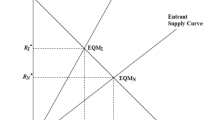Abstract
This paper studies a price and capacity decision for a telecommunications service provider that differentiates its products based on price and quality of service to maximize revenue. We assume the market is segmented into two customer classes. Time sensitive customers are willing to pay a price premium for a shorter service time, while price sensitive customers are willing to accept a longer service time in return for a lower price. The service provider offers products and services that differ only in their guaranteed service times and prices. We first develop a mathematical model to determine the optimal product price and optimal capacity necessary for maximizing total profit. We then consider a case where a service provider can marginally increase or decrease the capacity, and compute the optimal price and optimal capacity.






Similar content being viewed by others
References
Allon G, Federgruen A (2008) Competition in service industries with segmented markets, Working paper, Graduate School of Business, Columbia University, NY, USA
Blackburn JD (1991) Time-based competition: the next battleground in American manufacturing. Business One Irwin, Homewood
Boyaci T, Ray S (2003) Product differentiation and capacity selection cost interaction in time and price sensitive markets. Manufacturing and service operations management 5(1):18–36
Boyaci T, Ray S (2006) The impact of capacity costs on product differentiation in delivery time, delivery reliability and price. Prod Oper Manag 15(2):179–197
Chew EP, Lee C, Liu R (2009) Joint inventory allocation and pricing decisions for perishable product. Int J Prod Econ 120:139–150
Hill AV, Khosla IS (1992) Models for optimal lead time reduction. Prod Oper Manag 1(2):185–197
Hong K-S, Lee C (2011) Optimal pricing and guaranteed lead time with lateness penalties, International Journal of Industrial Engineering, to appear
Hopp WJ, Spearman ML (2000) Factory physics, 2nd edn. McGraw-Hill Higher Education, USA
Hum SH, Sim HH (1996) Time-based competition: literature review and implications for modeling. Int J Oper Prod Manag 16(1):75–90
Kaspi M, Rosenblatt M (1991) On the economic ordering quantity for jointly replenished items. Int J Prod Res 29:107–114
Kryvinska N, Thanh DV, Strauss C (2010) Integrated management platform for seamless services provisioning in converged network. IJITCC 1(1):77–91
Li L (1992) The role of inventory in delivery-time competition. Manag Sci 38:182–197
Mirceva G, Mirchev M, Davcev D (2010) Hidden Markov Models for classifying protein secondary and tertiary structures. Journal of Convergence 1(1):57–64
Palaka KS, Erlebacher S, Kropp DH (1998) Lead time setting, capacity utilization, and pricing decisions under lead time demand. IIE Trans 30(2):51–163
Pekgun P, Griffin PM, Keskinocak P (2006) Centralized vs. decentralized competition for price and lead-time sensitive demand, Working paper, School of Systems and Industrial Engineering, Georgia Institute of Technology, Atlanta, GA, USA
Prahmkaew S (2010) Performance evaluation of convergence Ad Hoc networks. Journal of Convergence 1(1):101–106
Rahman MZ, Pathan A-SK (2010) A case study: establishing redundant access networks in the telecommunication sector of a developing country. IJITCC 1(1):108–126
Ray S, Jewkes EM (2004) Customer lead time management when both demand and price are lead time sensitive. Eur J Oper Res 153(3):769–781
So KC (2000) Price and time competition for service delivery. Manuf Serv Oper Manag 2(4):392–409
So KC, Song JS (1998) Price, delivery time guarantees and capacity selection. Eur J Oper Res 111(1):28–49
Stalk G, Hout TM (1990) Competing against time. The Free Press, NY
Suri R (1998) Quick response manufacturing: a companywide approach to reducing lead times. Productivity Press, USA
Tsay A, Agrawal AN (2000) Channel dynamics under price and service competition. Manuf Serv Oper Manag 2(4):372–391
Urban TL (2009) Establishing delivery guarantee policies. Eur J Oper Res 196:959–967
Van Beek P, Van Putter C (1987) OR contributions to flexibility improvement in production/inventory systems. Eur J Oper Res 31:52–60
Acknowledgement
This research was supported by Basic Science Research Program through the National Research Foundation of Korea(NRF) funded by the Ministry of Education, Science and Technology (2009-0068528)
Author information
Authors and Affiliations
Corresponding author
Rights and permissions
About this article
Cite this article
Hong, Ks., Lee, C. Integrated pricing and capacity decision for a telecommunication service provider. Multimed Tools Appl 64, 389–406 (2013). https://doi.org/10.1007/s11042-012-1030-3
Published:
Issue Date:
DOI: https://doi.org/10.1007/s11042-012-1030-3




